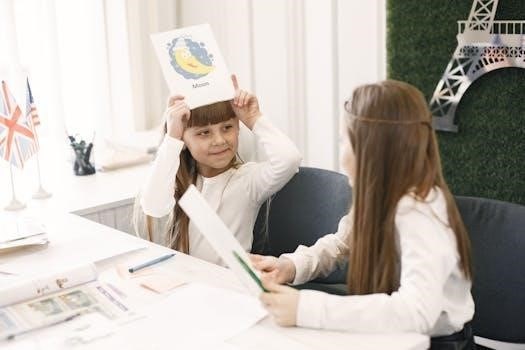end of the year report card comments for kindergarten pdf

Understanding Kindergarten Report Card Comments
Kindergarten report card comments are vital for communicating a child’s
progress to parents. These comments offer insights into academic growth,
social development, and work habits, setting the stage for future success.

The Importance of End-of-Year Comments
End-of-year comments on kindergarten report cards serve as a comprehensive
These comments offer valuable insights for parents, providing a clear picture
of their child’s strengths, areas for improvement, and overall progress in
meeting learning objectives. They highlight not only academic skills but also
social and emotional development, contributing to a well-rounded
understanding of the child’s kindergarten experience. Moreover, these
comments act as a bridge between teachers and parents, fostering collaboration
to support the child’s continued learning journey. Effective end-of-year
comments are specific, constructive, and growth-oriented, offering actionable
suggestions for parents to reinforce learning at home and prepare their child
for the next academic year. They represent a significant opportunity to
celebrate successes and address challenges collaboratively.
Categories of Kindergarten Report Card Comments
Kindergarten report card comments typically fall into categories⁚ positive
achievements, areas needing improvement, and suggestions for home support.
These sections provide a balanced view of the student’s progress and development.
Positive Comments Examples
“____________ demonstrates excellent classroom behavior and positively influences
classmates.” “____________ has shown significant improvement in behavior and is
maturing as a responsible student.” “____________ consistently adheres to
classroom rules and shows respect to peers and teachers.” “____________ actively
and respectfully participates in class discussions.” “____________ brings a
positive attitude and a smile to the classroom, making it a joy to teach
them.” “____________ displays a great capacity for self-discipline, managing
their behavior maturely.” “____________ demonstrates excellent social skills,
often taking the initiative to help peers and work collaboratively on
projects.” “____________ shows a high level of respect and kindness towards
classmates and teachers, contributing to a positive classroom environment.”
“____________’s ability to communicate effectively with peers and teachers is
commendable and has greatly improved this year.” “____________ has shown a
remarkable ability to resolve conflicts constructively and maintain positive
relationships with peers.”
Areas for Improvement Comments Examples
“____________ struggles with following classroom rules and needs to focus on
this.” “____________’s behavior can occasionally disrupt the class. Continued
effort to respect the learning environment is necessary.” “____________ has
difficulties in maintaining respectful behavior towards peers. Continued
practice in treating others kindly is required.” “____________’s behavior in
class can sometimes distract others. A focus on self-control could be
beneficial.” “____________ struggles with listening skills during instruction.
Focused attention during class could lead to improvement.” “____________
sometimes struggles with sharing and taking turns, which could be a focus for
improvement.” “____________ has had some difficulties working cooperatively in
a group setting. Continued practice in this area would be beneficial.” “It
would be helpful if ____________ could work on their communication skills to
express their thoughts and feelings more clearly.” “____________ often relies
on peers for help with assignments.”
Suggestions for Home Comments Examples
“Focused attention on his/her studies over the summer could be beneficial;”
“Continued practice and focus on this area over the summer could prove
beneficial.” “He/She would greatly benefit from implementing more effective
study habits.” “Continued effort to respect the learning environment is
necessary.” “Continued practice in treating others kindly is required.” “A
focus on self-control could be beneficial.” “Focused attention during class
could lead to improvement.” “Continued practice in these areas is
recommended.” “Fostering better attention skills will be crucial for the next
grade.” “A consistent effort will be crucial for their success in the next
grade.” “Utilizing resources and extra practice over the summer may help them
prepare for the challenges of the next grade.” “Continued practice in this
area would be beneficial.”

Key Elements of Effective Kindergarten Report Card Comments
Effective kindergarten report card comments should be specific, growth-oriented,
and aligned with learning objectives. These elements help parents understand
their child’s progress and how to support their learning journey.
Specificity and Clarity
Specificity and clarity are paramount in kindergarten report card comments.
Avoid vague statements and instead, provide concrete examples of a student’s
strengths and areas for improvement. For instance, instead of saying “shows
improvement in reading,” specify “identifies uppercase letters and recognizes
sight words.” This level of detail helps parents understand exactly what their
child is achieving.
Similarly, when addressing areas for growth, be clear about the specific
skills that need attention. Instead of writing “needs to improve in math,”
suggest “requires additional practice with number recognition and counting to
20.” Clear language ensures that parents can easily grasp the message and
take appropriate action to support their child’s learning.
Using precise language fosters a collaborative partnership between teachers and
parents.
Focus on Growth and Progress
When crafting kindergarten report card comments, focusing on growth and
progress is essential. Highlight the student’s development over the academic
year, emphasizing the skills they’ve acquired and the milestones they’ve
achieved. Even small steps forward deserve recognition, as they demonstrate
the child’s effort and potential. Frame comments to show improvement.
Instead of simply stating what a child can’t do, focus on what they are
learning to do. For example, “is beginning to write their name” is more
encouraging than “cannot write their name yet.” This approach instills
confidence and motivates the student to continue striving for progress.
Acknowledging effort and perseverance, even when the end result isn’t perfect,
is crucial for fostering a growth mindset.
Alignment with Learning Objectives
Effective kindergarten report card comments should clearly align with
established learning objectives. These objectives, often outlined in the
kindergarten curriculum, serve as benchmarks for student progress. When
writing comments, teachers should reference specific skills and concepts that
were taught throughout the year.
For example, if a learning objective was to identify and write uppercase
letters, a comment could state, “demonstrates proficiency in identifying
uppercase letters and is beginning to form them correctly.” This directly
connects the student’s performance to a specific learning goal. Similarly,
comments about social skills should reflect objectives related to cooperation,
respect, and conflict resolution.
By aligning comments with learning objectives, teachers provide parents with a
clear and concise understanding of their child’s academic strengths and areas
for improvement.

Examples of Positive Academic Comments
Positive academic comments on a kindergarten report card highlight a student’s
strengths and achievements in various subject areas. These comments should be
specific and descriptive, focusing on demonstrated skills and progress made
throughout the year. For example, in reading, a comment could state, ”
consistently demonstrates strong phonemic awareness and enjoys sounding out
new words.”
In mathematics, a positive comment might be, “exhibits a solid understanding
of number concepts and can accurately count to 20.” When addressing writing
skills, a teacher could write, “is developing fine motor skills and is able
to write their name legibly.” These comments not only recognize a child’s
successes but also encourage continued growth and enthusiasm for learning.
Furthermore, positive comments can mention specific projects or activities
where the student excelled, reinforcing their confidence and highlighting
their unique talents.
Examples of Comments on Social Skills and Behavior
Comments on social skills and behavior in kindergarten report cards provide
insight into a child’s interactions with peers and their conduct in the
classroom. Positive comments often highlight cooperation, empathy, and
respectful behavior. For instance, a teacher might write, “demonstrates
excellent social skills, often taking the initiative to help peers and work
collaboratively on projects.” Another positive comment could be, “shows a
high level of respect and kindness towards classmates and teachers,
contributing to a positive classroom environment.”
Additionally, comments may praise a child’s ability to resolve conflicts
peacefully, stating, “has shown a remarkable ability to resolve conflicts
constructively and maintain positive relationships with peers.” These
observations underscore the importance of social-emotional learning in early
childhood and provide parents with a clear understanding of their child’s
strengths in these areas.
Conversely, comments may also address areas needing improvement while
maintaining a constructive and supportive tone.

Examples of Comments on Work Habits
Work habits are crucial for kindergarteners, setting the stage for future
academic success. Report card comments in this area often address a student’s
ability to stay focused, complete tasks, and demonstrate responsibility. A
positive comment might state, “has shown consistent dedication to
his/her work, demonstrating good organizational skills and focus.” Another
example could be, “has made significant improvements in managing his/her time
effectively and completing assignments on time.”
Teachers also highlight a child’s initiative and independence with comments
like, “has demonstrated a high level of responsibility and commitment in
his/her work habits throughout the year” or “has shown a consistent ability
to work independently and take initiative in his/her learning.” These
remarks acknowledge the student’s growing ability to manage their work
effectively.
Conversely, comments may also address areas where a student could improve,
always framing the feedback constructively to encourage growth.
Tips for Writing Constructive Criticism
Delivering constructive criticism in kindergarten report card comments
requires careful consideration. The goal is to provide feedback that
encourages growth without discouraging the student or their parents. Begin by
sandwiching any negative feedback between positive observations. For example,
start by acknowledging a student’s strengths before addressing areas for
improvement.
Specificity is key. Instead of vague statements like “needs improvement,”
provide concrete examples of the behavior or skill needing attention. Use
phrases such as “struggles with following classroom rules” or “would benefit
from additional practice in letter recognition.” Always focus on the behavior
or skill, not the child’s character.
Frame criticisms as opportunities for growth. Suggest strategies for
improvement, such as “continued practice at home” or “focusing on active
listening during instruction.” End with a positive note, reinforcing your
belief in the student’s potential and willingness to support their
progress. This approach ensures that the criticism is received as helpful
guidance.
Time-Saving Strategies for Teachers
End-of-year report card comments can be a time-consuming task for
kindergarten teachers. However, with effective strategies, you can streamline
the process without sacrificing the quality of your feedback. Start by
creating a bank of reusable comments categorized by subject area, skill, and
behavior. This allows you to quickly adapt and personalize comments for each
student.
Utilize templates and sentence starters to expedite writing. For instance,
begin with phrases like “_____ has shown growth in…” or “_____ would
benefit from additional practice in…” This provides a structure to build
upon, saving time on brainstorming. Consider using mail merge features in
word processing software to personalize comments with student names and
specific details.
Collaborate with colleagues to share ideas and resources. This can help you
discover new approaches and avoid reinventing the wheel. Finally, allocate
specific time slots for writing comments and stick to the schedule. By
implementing these time-saving strategies, you can efficiently create
meaningful and informative report card comments.